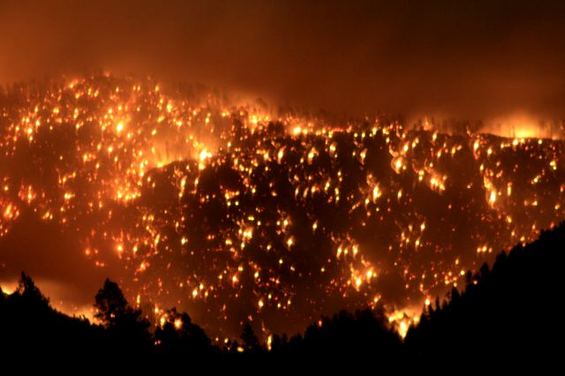
Here is a link to today’s article in the Denver Post, and below is an excerpt.
The commission also may make “compensatory recommendations” after hearing from victims of the fire, who were expected to testify in Conifer on Monday night.
“Realistically, we’re talking about many months, if not over years” before victims see special compensation from the state, said commission chairwoman state Sen. Ellen Roberts, R-Durango .
Mike Babler, fire programs manager for the Colorado chapter of the Nature Conservancy , said wildfires are becoming more frequent and more intense.
Babler said prescribed burns, which the state put an indefinite ban on after the Lower North Fork fire, are still important for fire management. But he listed a variety of other strategies, including defensive techniques such as cleaning up pine needles and other fuel around homes.
Another major factor has been the collapse of the timber industry, Babler said. With a depressed construction industry and foreign competition, mills have been shuttered, leaving forests thicker with fuel.
He also pointed to the growth of those living in the “urban wilderness interface,” where development creeps into forests. Two million people in Colorado now live in these areas, and studies say that could double in 20 years, he said.
In California on Monday, more than 825,000 rural residents received bills from the state of up to $150 for fire protection costs.
The controversial new fees are expected to raise $84 million to help balance the state budget.
Sharon’s questions: Does someone have a link to the California policy? Also, it’s still not clear to me why the taxpayers of Colorado (say, the person working at the 7-11) should be compensating these folks. Is it for something their insurance does not cover? Does the policy of “no prescribed burns” really make any practical sense? Is there really such a policy in the State (I haven’t been following this)? Finally, I wonder if the studies of the doubling of populations in the WUI takes into account the economy, and the distribution of wealth. If we can’t predict that, what can we predict? Sensitivity analysis might be useful.
These government funded bail-outs are not for the homeowner, they’re for the home insurance industry. Insurance companies do anything they can to shift the costs of home losses to someone else. Who better than government, i.e., everyone, especially when government ignited the fire. That the same land would have burned regardless, and probably at even higher intensity, is irrelevant to legislators currying favor with the insurance industry.
The same thing happened after the Los Alamos fire. Only it was Congress, with its big wallet, that wrote the checks to the insurance industry. The state of Colorado will be a bit more frugal because it can’t print money.
How cool is that? Collect the premiums and not have to make the pay-out?
The fire fee is to support CAL FIRE operations, which are consuming an increasingly-massive sum of the state’s general fund budget each year. Those who choose to keep expanding the urban-interface zone are putting increasing pressure on firefighters in State Responsibility Areas, and I find it only fair that they be asked to pay their fair share.
Brown has said that the cash-strapped state can no longer afford the entire cost of battling blazes in fire-prone areas. The new fee could raise as much as $200 million a year from the more than 846,000 homeowners who live within more than 31 million acres of “state responsibility areas,” where Cal Fire is the primary responder.
A spokesman for the governor said the levy will “ensure that landowners in these areas that receive a disproportionate benefit from Cal Fire’s services pay an appropriate portion of the state’s wildland firefighting costs.”
http://articles.latimes.com/2011/jul/18/local/la-me-fire-fee-20110718
Then we should also add earthquake fees, levee fees, crime fees, highway fees etc, for the very same reasons that people choose to live in such areas. I don’t wish to pay for the costs of all of them choosing to live in hazardous areas. Much of the LA area is in hazardous fire areas. Will ALL of them be paying the fee, too?
There are highway fees. They’re called gasoline taxes – the more you drive, the more you pay for roads. The user pays for the service.
Your “earthquake fees” comparison is ridiculous. There hasn’t been a major, widely-destructive earthquake in California since 1994. The state doesn’t pay for thousands of “earthquake-fighters” around the state whose job is to “suppress earthquakes.” Wildland-urban interface fires happen multiple times every year.
Fact: Rural Californians want urban Californians to spend their tax dollars on subsidizing low fire insurance rates.
I love libertarians who suddenly turn collectivist the minute they’re asked to pony up user fees for the essential government services they use.
Of course, the earthquake fees are ridiculous but, my point is still valid. The government, as well as private industry, pays plenty each year, for earthquake preparedness, building design, and other earthquake-related costs. Additionally, I don’t want my taxes to pay for more roads in metropolitan areas. If traffic gets bad, people should move where it isn’t bad.
If we managed our lands properly, we wouldn’t need so much fire protection. Preserving unnatural amounts of fuels, then turning around and pushing for more “wildland fire” is as ridiculous as earthquake fees.
Also, I refuse to be politically labeled. I don’t depend on political parties to tell me what to think.